
views
Dusting and Vacuuming Your Blinds

Wipe the blinds from top to bottom with a thick duster. Close the blinds so one of the flat sides faces you. Start at the top of the blinds, using a thick duster to brush the dirt downward. Work from the left side of the blinds to the right until they’re dust-free. Turn the rod attached to the blinds to rotate them so the other flat side faces you, and clean it with the duster as well. Avoid using a cloth or a light feather duster since they move dirt instead of picking it up off of the surface. Always be super careful when handling your blinds—a lot of designers only attach them with a thin piece of plastic that's easy to break.Tip: If your duster gets covered with particles and isn’t picking up any more dust, shake it off outdoors or wipe it clean with a microfiber cloth.

Remove any remaining dust with the brush attachment on your vacuum. Put the bristle-brush attachment on the hose of your vacuum and turn it on. Brush the bristles on the tops of the individual blinds and work down to the bottom. The brush attachment will help reduce the amount of suction and will get any dust stuck in the blinds. Keep working on one side of the blinds before vacuuming the other side. Don’t try to use a vacuum without an attachment since the suction could damage the blinds. Avoid vacuuming upward from the bottom since the blinds could unhook and fall off.

Clean your blinds weekly to prevent buildup. Add cleaning your blinds to your weekly list of chores so the dust doesn’t have a chance to build up. Be sure to dust and vacuum them each time even if they don’t look dirty since a thin layer of dust may have settled on them. Regular cleaning helps preserve your blinds and reduces the amount of time you need to spend deep-cleaning them.
Spot-Cleaning the Blinds
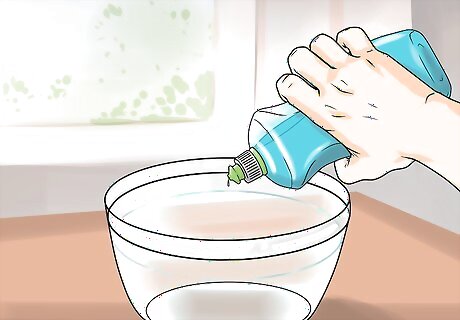
Fill a bowl with water with a few drops of dish soap. Mix 4 cups (950 ml) of warm water and 1 tablespoon (15 ml) of liquid dish soap in a large mixing bowl. Agitate the water by hand to make it sudsy so the soap is completely mixed in. Liquid dish soap works great for plastic, vinyl, and fabric blinds. All-purpose cleaner will also work for this.Tip: If you have wooden blinds, you can also use equal amounts of vinegar and warm water to make a cleaning solution.
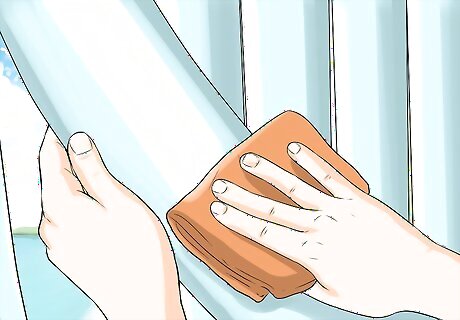
Wipe the blinds from the top to the bottom with a microfiber cloth. Dip a microfiber cloth or a sponge in the soapy water and wring it out as much as possible. Apply the soapy water onto your blinds starting from the top of the spot you’re cleaning. Work your way down until it’s saturated with soapy water. Don’t rub fabric blinds too hard or else they could start to fray and break.
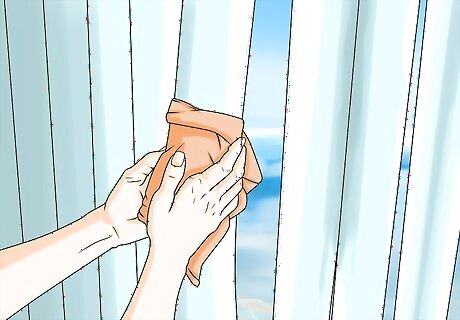
Clean off the soap with another damp cloth. Wet another microfiber cloth in clean water and wipe the surface of your blinds with it again. Try to lift up as much of the soapy water as you can so it doesn’t leave marks or spots on the blinds. Wring the cloth out if you need to so you don’t spread the suds back onto the blinds. Press your nondominant hand on the other side of the blinds as you pat them dry. That way, the soapy water will come out from fabric blinds easier.

Let the blinds air dry. Open the blinds so there’s space between them and leave them to dry. Let them stay open until they’re dry to the touch, which should take 1-2 hours. Once they’re dry, you can close them as you normally would. Avoid opening the window or door behind the blinds since outside dust could blow in and get stuck on them.
Washing Blinds in a Bathtub
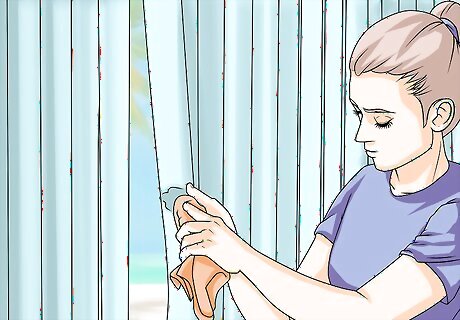
Wipe each blind with a microfiber cloth to remove dust. Work from the top of your blinds toward the bottom so you can remove the dust on the surface. After each individual blind, shake off the microfiber cloth so you aren’t spreading the dust around more. When you’re finished, turn the blinds and wipe the other side. Plastic and vinyl blinds can be cleaned easily in the bathtub. Check the tag on fabric blinds to see if they’re safe to be submerged completely in water.
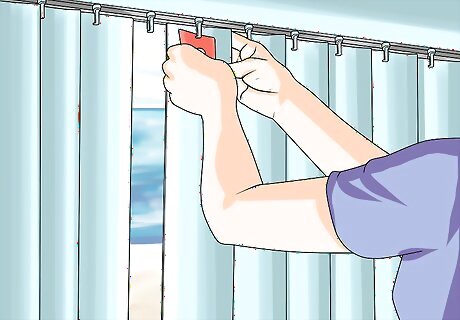
Unhook the blinds from the rail. Open your blinds so they aren’t overlapping and you can handle each one individually. Grab the top of one of the blinds and use your finger to open the grip on top. Once it’s loose, pull the blind down and lay it flat on a table or the floor. Slide a credit card between the grip on top and the blind to easily pull the blinds out. You can take all of the blinds off or you can work with a few at a time.
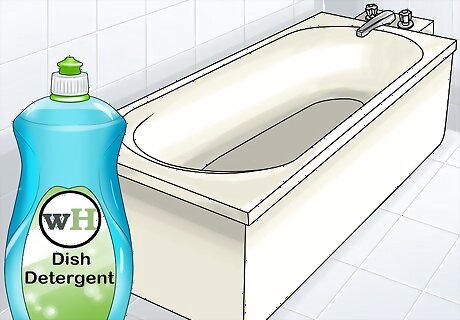
Fill the bathtub with warm water and dish soap. Use water that’s warm, but not too hot to the touch. Keep filling the tub until you can completely submerge your blinds in the water. Put a few drops of liquid dish soap in the tub to help clean off any dirt or grime from the blinds. Make sure the water isn’t over 85 °F (29 °C) or else it could damage the blinds. If you don’t have a bathtub, you can also use a large sink.
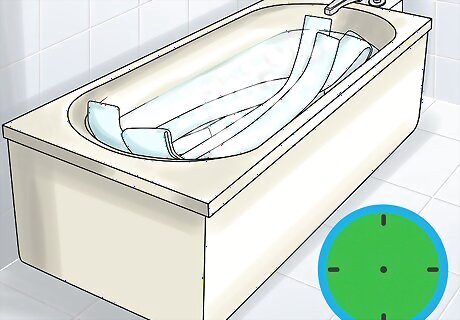
Soak the blinds for about 1 hour. Set your blinds in the tub and make sure they’re completely submerged in the water. Leave them alone for at least 1 hour so the dirt and dust will come off of them. After an hour, drain the tub and let any excess water drip off. Tip: If your blinds don’t easily bend, don’t try to force them into the tub since you could break them. Instead, submerge half of the blind for 30 minutes and then rotate it to soak the other half.
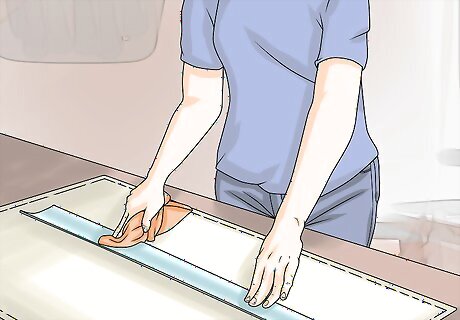
Wipe the blinds with a cloth and lay them on a towel to dry. Lay towels out on the ground so they’re long enough to hold the blinds. Pick up the blinds and wipe them off as much as you can with a clean microfiber cloth. Lay the blinds flat on the towels and let them dry for about 1-2 hours. You can also hang your blinds back on their hooks to dry. Make sure there’s space between them and you lay a towel on the floor underneath them. Fabric blinds may take longer to dry completely.
Using a Washing Machine
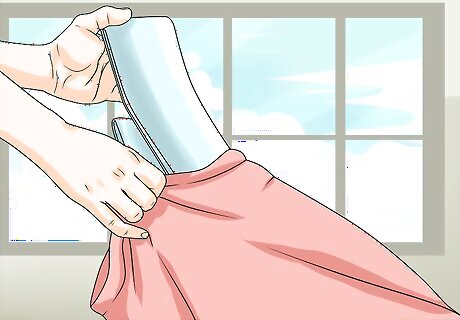
Place your blinds in a pillowcase before putting them in the washer. Take the blinds off of their hooks and fold them in half. Put your blinds inside of a large pillowcase and tie it shut so they don’t fall out. Set the pillowcase inside your washing machine. The pillowcase will help prevent the edges of the blinds from fraying or getting caught in the machine. Check your blinds’ label to see if they’re safe to wash in a machine. Many fabric vertical blinds can be washed like regular laundry. You can also use a laundry bag with a zipper if you don’t have an extra pillowcase.
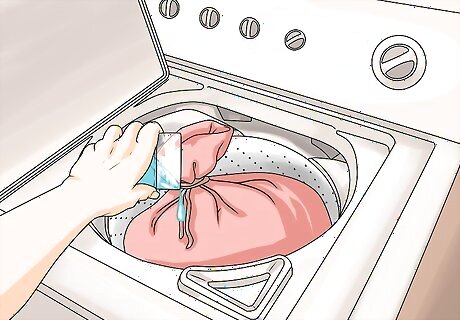
Add a gentle liquid detergent. Look for a laundry detergent that’s labeled as gentle so it doesn’t damage your fabric. Use the amount listed on the packaging, and pour it into the compartment if it’s a front-loading machine or directly in the drum if it’s top-loading.

Set the washing machine to a delicate cycle with warm water. Select the cycle made for delicate fabrics or on the lowest setting so it doesn’t damage the blinds. Then change the water temperature to warm so the detergent works well. Close the machine and run the cycle in its entirety. Avoid using the hottest cycle since it could cause damage to your blinds since some fabric blinds have glue that could break down when it’s heated.
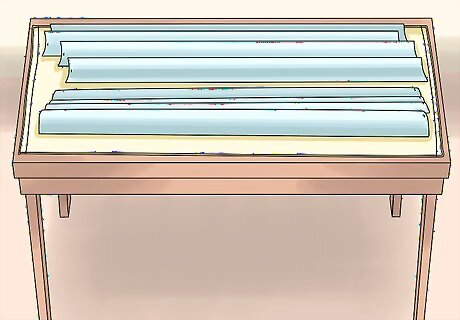
Let the blinds air-dry after they’ve been washed. Put out a layer of towels on your floor or on a table that can hold the blinds. Take the blinds out of the pillowcase and lay them flat on the towels so they can dry. Leave them for a few hours until they’re dry to the touch. You could also hang the towels back on their hooks if you don’t want to lay them on the floor.
















Comments
0 comment